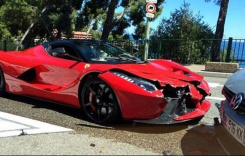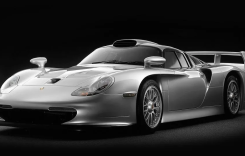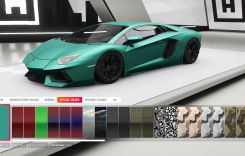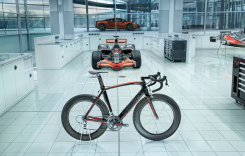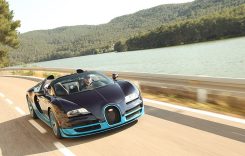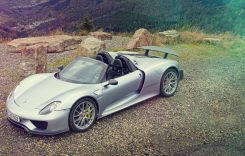The impressive engine’s performance hinges on its big 112mm (4.409 in.) pistons operating at a relatively short 90.5mm (3.563 in.) stroke. A two-stage cam drive system with four-valves atop each cylinder helps keep the cylinder

The 2009 Suzuki M109R is easily identifiable by its signature headlight cowl and wide-bodied fuel tank. Big 2-1-2 pipes and a powerful 1783cc engine are also familiar traits.
head design and the stroke compact. Healthy dual-butterfly 56mm throttle bodies ignited by two spark plugs keep the beast fed, and the same Suzuki Composite Electrochemical Material (SCEM) that is used in its race bikes lines the cylinder walls to keep those big pistons churning smoothly. The 54-degree V-Twin is also liquid-cooled to assist in its efficiency. The big powerplant has six rubber mounts and a contra-rotating balance shaft between the crank and countershaft that help quell vibrations yet still allow enough of the lumping V-Twin experience that cruiser riders demand. We did experience quite a bit of engine noise though, a peculiar unidentified brushing sound at idle that sounds like something is rubbing as it spins.
A 32-bit ECU controls the electronic fuel injection, and as long as you’re on the throttle, the flow is constant and even. But ease up a bit and the bike’s power cuts back noticeably. It’s either pulling like a horse or dropping you back in the seat when it stops surging and you’re constantly wrestling with the jerky extremes. Stay on the throttle and the M109R’s fuel delivery is fine, but if you ease up a bit it can get a little spotty, especially noticeable around 3000-3200 rpm. This fueling issue affects it when starting as well. Despite the fact that it has Suzuki’s Idle Speed Control system tailored to
assist in cold starting, we found the M109R to be a cold-blooded beast by nature. You can’t just fire it up and go. Try to take off before it’s warmed up and it will cut out on you when trying to accelerate. And this despite it never having to deal with particularly cold mornings.
The M109R’s power is transferred to the rear wheel via a 5-speed constant mesh transmission coupled with a shaft drive system. If you’re not deliberate with your shifts, the clunky tranny performs similar to those found in American V-Twins. Get it past the first couple of gears and it’s a tad more compliant, but you still can’t be lazy with your shifts without it protesting a bit. It also is difficult to kick into first from neutral at times. We did find that clicking it down a gear when approaching a stop light applies a tremendous amount of engine braking.
Getting off the line, the 1783cc engine has no problems setting the M109R’s 240mm rear Dunlop D221 Sportmax radial into motion. The back
You feel the girth of the 2009 Suzuki M109R during slow-speed maneuvers but it is very stable when banked over and has a decent lean angle thanks to its healthy 5.1-in. of ground clearance.
end will grip and go, but its 778.5 lbs of curb weight and wide backside also means it needs more encouragement in the twisties and at low speeds. To get it tilted over in tight turns requires a little work at the drag-style handlebars and its big 240mm rear tire has a flat profile that doesn’t facilitate the process, but once you get it banked over the motorcycle is very stable. You can also get a decent lean angle thanks to its 5.1-in. of ground clearance. As far as ride quality, its suspension is fairly firm. On the front end, an inverted Kayaba telescopic fork has a generous 5.12 in. of travel, but the single rear shock is stiff. It takes a lot to compress the link-type coil spring. The rear is adjustable for preload, which admittedly we didn’t tinker with, a factor that potentially would have softened the rigidness of the rear. We did discover that if you dole out too much of its bountiful power too fast, its shaft drive can jack the rear suspension, so use the throttle wisely.
With big power and a lot of mass, the M109R fortunately has a powerful set of brakes. The front is anchored by twin 310mm discs with radial-mount Tokico four-piston calipers. The front set-up has great stopping power but could use a touch more feel at the lever. The rear arrangement features a 275mm disc with dual-piston calipers that offer progressive stopping power and don’t lock up easily but also don’t have much feel at the pedal.
Big V-Twins with 5-speed transmissions mounted in double cradle frames in long, low power cruisers mean its comparison time once again.
The M109R is easily recognizable by its signature headlight cowl. Its radiator is also encased in a large plastic shroud that adds to the hefty appearance of its front end. Its 5.2-gallon tank is very wide and serves as an ample platform for its tank-mounted console. The M109R has a wide, easy-to-read analog speedo that includes a digital fuel gauge, odometer and dual tripmeters. It has a separate handlebar-mounted digital tach that is a nice touch. The tach contains indicator lights for low fuel, oil temp and a neutral indicator, but the low fuel light begins flashing at a certain point and can be distracting while riding. A five-way adjustable brake lever is also a bonus.
The M109R has big pipes that look and sound great. It emits a deep, rich exhaust note that you can feel inside your bones and complements the bike’s muscular stance. The machined heads on the engine are a sweet styling touch too, but the work is obscured because the engine is so tightly packed between the bulky plastic molding around the radiator, below the big fuel cell and behind a big plastic air cleaner cover. More cost-saving measures like plastic fenders and the oil tank cover also diminish the quality of its fit and finish.
2

